







Looking After Your Finds - Identification - Finds




Assyrian - Cimmerian Horse Attire


Powered By Sispro1

Fibulae1
1. ASSYRIAN BRONZE HORSE FRONTLET - 7th century B.C.
Sheet bronze frontlet, covering from forehead to nose with segments cut out from sides for eyes. Two attachment loops ( at the top and at the center on the reverse side) with two rivets for each loop. L.13.4"(34 cm), W. 10.1"(25.7 cm).
2. ASSYRIAN BRONZE HORSE FRONTLET - 7th century B.C.
Sheet bronze frontlet, covering from forehead to nose with segments cut out from sides. Numeric concentric circles with raised central boss inscribed in forehead section. Below, three columns of concentric circles with raised dots in the center of each. Two attachment loops ( at the top and at the center on the reverse side) with two rivets for each loop.
L. 13" (33.2cm), W. 5"(12.7 cm).
3. CIMMERIAN BRONZE BRIDLE - 8th century B.C.
Each side of the snaffle bit was cast as a single unit with double rings at the ends. The outer with free moving disk termination to which the cheek-straps were attached. Pair of blade-type cheekpiece (psalia) with three rings and terminated by horizontal disk. Lunate plaque with five discs and two termination volutes. Both plagues have horizontal loops on the back.
L. 8"(20.3 cm) for mouth-bit.
4. BRONZE BRIDLE BITS - 8th century B.C.
Cast as one piece. Round interlocking center rings in perpendicular planes to each other. Corrugated bars are shown as spirally wound wire and terminated on each end with stirrup-shaped loops. Central part is movable. L. 6.6"(16.8 cm)
5. PAIR OF BRONZE AND IRON CHEEKPIECES - 7th -6th century B.C.
Complicated metallurgical workmanship combining iron and bronze. Figure "8"-shaped central iron parts with two opening for attachment to bits and bridle. The rest of "S"-shaped cheekpieces are in bronze, with round cross-sections and semi-spherical terminations. Both are broken in the center and mended. L. 4. 9"(12.4 cm).
6. BRONZE CHEEKPIECE - NORTHWESTERN IRAN - 7th century B.C.
Cast bronze. Arc-shaped cheekpiece (psalia) with three ribbed cylindrical rings. One end is pointed, the other is in the form of a naturalistically modeled horse's leg with hoof. Intact.
L. 4. 6"(11.6 cm).
7. SCYTHIAN BRONZE CHEEKPIECE - 4th century B.C.
Cast bronze. Fragment of a cheekpiece (psalia). Depicting stylized foot of bird of prey, with prominent knuckles and claws. One opening in the middle of cheekpiece for attachment to bits and bridle. L. 2. 3"(6 cm).
8. BRONZE STRAP FINALS - 6th-5th century B.C.
Cast bronze. Part of a horse bridle (pair of strap finals). Truncated cone with conical opening.
H. 1.1cm, D. 1.6 cm.
9. BRONZE BRIDLE ELEMENTS 6th-5th century B.C.
Cast bronze. Four half-sphere loops with convex shields. - L. 11 mm, H. 11 mm.
10. BRONZE BRIDLE ELEMENTS - 6th-3rd century B.C.
Cast bronze. 1) Part of a horse bridle (strap final). Truncated cone with conical opening.
H. 1.4 cm, D. 1.3 cm. 2) Half-sphere loop with convex-shaped domed center and fringed perimeter. L. 1.1 cm, W. 1.6 cm. 3) Hemispherical shield with diametrical loop.
H. 0.6 cm, D. 1.2 cm.
11. BRONZE BRIDLE STRAP GUIDES - 7th -6th century B.C.
Cast bronze. 1) 3 cylindrical harness rings: with opening in perpendicular direction, casting "sprue" is on the side. H. 0.6 cm, D. 1.5 cm. 2) rhomboidal prism harness ring for the bridle strap crossing with an opening through on each side.
Sheet bronze frontlet, covering from forehead to nose with segments cut out from sides for eyes. Two attachment loops ( at the top and at the center on the reverse side) with two rivets for each loop. L.13.4"(34 cm), W. 10.1"(25.7 cm).
2. ASSYRIAN BRONZE HORSE FRONTLET - 7th century B.C.
Sheet bronze frontlet, covering from forehead to nose with segments cut out from sides. Numeric concentric circles with raised central boss inscribed in forehead section. Below, three columns of concentric circles with raised dots in the center of each. Two attachment loops ( at the top and at the center on the reverse side) with two rivets for each loop.
L. 13" (33.2cm), W. 5"(12.7 cm).
3. CIMMERIAN BRONZE BRIDLE - 8th century B.C.
Each side of the snaffle bit was cast as a single unit with double rings at the ends. The outer with free moving disk termination to which the cheek-straps were attached. Pair of blade-type cheekpiece (psalia) with three rings and terminated by horizontal disk. Lunate plaque with five discs and two termination volutes. Both plagues have horizontal loops on the back.
L. 8"(20.3 cm) for mouth-bit.
4. BRONZE BRIDLE BITS - 8th century B.C.
Cast as one piece. Round interlocking center rings in perpendicular planes to each other. Corrugated bars are shown as spirally wound wire and terminated on each end with stirrup-shaped loops. Central part is movable. L. 6.6"(16.8 cm)
5. PAIR OF BRONZE AND IRON CHEEKPIECES - 7th -6th century B.C.
Complicated metallurgical workmanship combining iron and bronze. Figure "8"-shaped central iron parts with two opening for attachment to bits and bridle. The rest of "S"-shaped cheekpieces are in bronze, with round cross-sections and semi-spherical terminations. Both are broken in the center and mended. L. 4. 9"(12.4 cm).
6. BRONZE CHEEKPIECE - NORTHWESTERN IRAN - 7th century B.C.
Cast bronze. Arc-shaped cheekpiece (psalia) with three ribbed cylindrical rings. One end is pointed, the other is in the form of a naturalistically modeled horse's leg with hoof. Intact.
L. 4. 6"(11.6 cm).
7. SCYTHIAN BRONZE CHEEKPIECE - 4th century B.C.
Cast bronze. Fragment of a cheekpiece (psalia). Depicting stylized foot of bird of prey, with prominent knuckles and claws. One opening in the middle of cheekpiece for attachment to bits and bridle. L. 2. 3"(6 cm).
8. BRONZE STRAP FINALS - 6th-5th century B.C.
Cast bronze. Part of a horse bridle (pair of strap finals). Truncated cone with conical opening.
H. 1.1cm, D. 1.6 cm.
9. BRONZE BRIDLE ELEMENTS 6th-5th century B.C.
Cast bronze. Four half-sphere loops with convex shields. - L. 11 mm, H. 11 mm.
10. BRONZE BRIDLE ELEMENTS - 6th-3rd century B.C.
Cast bronze. 1) Part of a horse bridle (strap final). Truncated cone with conical opening.
H. 1.4 cm, D. 1.3 cm. 2) Half-sphere loop with convex-shaped domed center and fringed perimeter. L. 1.1 cm, W. 1.6 cm. 3) Hemispherical shield with diametrical loop.
H. 0.6 cm, D. 1.2 cm.
11. BRONZE BRIDLE STRAP GUIDES - 7th -6th century B.C.
Cast bronze. 1) 3 cylindrical harness rings: with opening in perpendicular direction, casting "sprue" is on the side. H. 0.6 cm, D. 1.5 cm. 2) rhomboidal prism harness ring for the bridle strap crossing with an opening through on each side.
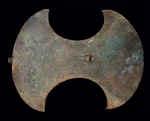




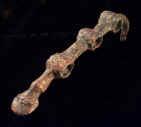


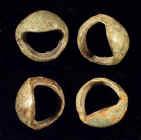
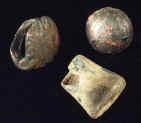
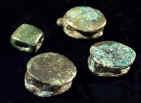
12. STONE BRIDLE STRAP GUIDES - 7th -6th century B.C.
Polished stone cube with pyramid top and four openings, drilled in perpendicular direction.
L. 15 mm, H. 15 mm.
Polished stone cube with pyramid top and four openings, drilled in perpendicular direction.
L. 15 mm, H. 15 mm.
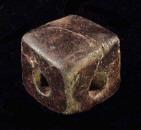
Copyright All Rights Reserved by Nigel G Wilcox E-Mail: ngwilcox100@gmail.com
Designed by Nigel G Wilcox
Complimentary Topics
The Paragon Of Metal Detecting
& Archaeology
& Archaeology
Tudor Jewellery - Pendants >>>
Specialised. Menu
Pages
Main Coin Menu
Member NCMD






















